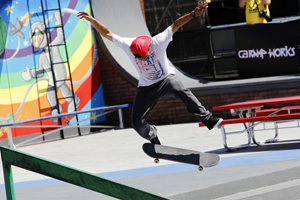Skateboarding, hip-hop foster artistic expression similarly
January 22, 2013
My appreciation for hip-hop came as a result of skateboarding. I was fascinated with the creative ways that the so-called rappers at my high school made fun of us skateboarders.
This was of course before Odd Future — a group of Los Angeles skaters who also create rap music — and well before Lil Wayne made appearances in skate videos.
The two lifestyles are under an interesting and entirely unexpected spotlight and have recently collaborated to form groups that combine them.
Skateboarding has crossed boundaries to make appearances in less traditional places. Fairfax Avenue in Los Angeles is adorned with a giant Diamond Supply Co. billboard. The same company that made maddeningly complicated skateboard hardware for grungy kids who didn’t shower and hung out with bums has its logo sprawled above the glitzy cityscape. It’s almost surreal.
Similarly, hip-hop’s mainstream appeal comes as somewhat of a surprise, considering the genre was once marred by violence and negative public perception.
What’s even more fascinating is how these two worlds that couldn’t seem more different from each other are increasingly becoming intertwined. In the music video for 2 Chainz’s “No Lie,” there is a slow-motion shot of professional skateboarder Theotis Beasley doing a kickflip. This 2 Chainz video regularly airs on Black Entertainment Television (BET), which frequently features rap and hip-hop music.
Growing up, I would have never imagined this sort of collaboration.
It makes sense, though. As skateboarders, we wore tight pants and listened to weird music. We snuck out of class using the same escape routes as the so-called gangsters and “future rappers.” It was only a matter of time until the groups would cross paths on the road leading farthest from authority figures. Of course, the Internet helped, too.
The racial undertones that exist in both spheres can’t be ignored either. Skateboarding was once relegated to sunny California beach communities not known for diversity, and made up of predominantly white residents. Slowly but surely, the sport made its way to the streets, unregulated, and skate rats could pick up a board in any neighborhood, in any city and make something from nothing.
Skateboarding relies on the same hip-hop ethic, the idea of being in complete control of artistic expression. Skater Stevie Williams calls himself “the Jay-Z of skateboarding” and no one stops him, mainly because the once-homeless Philadelphia kid started an empire named “Dirty Ghetto Kids.” If Jay-Z were a skateboarder, he’d have made the same move.
The skating clothing has become the closest relation to the rap world, and, rather quickly, skate brands such as Supreme, Diamond Supply, Vans and Huf have become stalwarts in the rap community. These brands, started and run by skateboarders, are a part of the hip-hop ethic and appeal to rappers because of their similar independent production.
This might explain the frequency of skate themes in so many modern rap movements. Odd Future’s aesthetic, wholly reliant on skate culture and built around skateboarders, is one of a number of skate forays into the rap industry. It’s a natural progression that led to East Coast counterweight Pro Era, a group headed by Joey Bada$$, which has a similar skate-centered niche. Much like the differences between rap music from either coast, these two groups highlight the multitude of aesthetics in skateboarding depending on location.
The parallels between these two worlds highlight a shift in societal acceptance, whereas rap music and skateboarding once shared a sort of ostracization from the mainstream. Today, however, their DIY ethic has created a new mainstream.
Write Jeff at [email protected].







